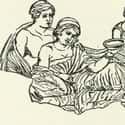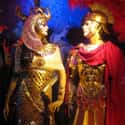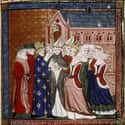-
(#8) A Sad Ancient Suicide Pact
The Parties Involved: Sophonisba, Masinissa, and Syphax
Meet Carthaginian lady Sophonisba, a sticking point between two of ancient Rome's great enemies in North Africa. Engaged at one point to Masinissa, king of the eastern Numidians, she was instead married off to Syphax, king of the western Numidians.
Syphax and Masinissa both opposed the Romans, but then these rival monarchs got into it with each other. When the Romans captured Syphax, Sophonisba came under Masinissa's protection, and she convinced him to fall for her.
"Sophonisba was in the bloom of youth and in all the splendor of her beauty, and as she held Masinissa's hand and begged him to give his word that she should not be surrendered to the Romans, her tone became one of blandishment rather than entreaty," wrote the ancient historian Livy. The two once-betrotheds got married bigamously.
By this time, Masinissa had switched sides and supported the Romans. His allies uncovered this, however, and wanted Sophonisba as a prisoner. Rather than go into slavery amongst the Romans, Sophonisba committed suicide. This epic romance became a popular subject for tragic plays in the Renaissance and beyond.
-
(#7) The Fraternal Triangle That Spiced Up Dante
The Parties Involved: Lady Francesca da Rimini, Gianciotto da Malatesta, and Paolo da Malatesta
This love triangle was a relatively minor episode in Italian history, but was retold in Dante's Divine Comedy and a Tchaikovsky opera. As a result, it became an infamous dramatic episode in literature and art.
The real story? In thirteenth century Italy, a lady from Ravenna (the young Francesca da Rimini) was betrothed to another noble named Gianciotto da Malatesta. Rumor had it, though, that she was in love with Gianciotto's hot younger brother, Paolo, and the two had a torrid affair. As a resut, Gianciotto took the lives of both his wife and brother.
Although the people were real, their adultery isn't provable (the family alliances didn't suffer after the kids' deaths, for example). Artists, however, picked up on this salacious story. Their contemporary, Dante Alighieri, brought the images to life in his epic poem; it remained a popular piece of hot gossip in the Western canon for centuries. From epic operas to plays, paintings to poems, Francesca and the Malatesta boys remained a titillating subject.
-
(#4) The Trio That Ended The Roman Republic
The Parties Involved: Mark Antony, Cleopatra, and Octavia
The last Ptolemaic pharaoh of Egypt, Cleopatra VII, had celebrated romances with both Julius Caesar and his protégé, Mark Antony. But the real love triangle came with her, Antony, and Antony's wife/Caesar's great-niece (and sister of his archrival), Octavia. It was partially over Antony's abandonment of Octavia, some say, that Antony and Octavian (later known as Rome's first emperor, Augustus) went to battle one last time and the Roman Empire was created.
In 40 B.C.E., Octavian and Antony were butting heads as co-rulers of Rome (with Lepidus). To smooth over rough edges between these guys, Antony married Octavian's sister; a few years later, Octavia even helped bring about a treaty between the two. But this didn't last forever; Antony went off on a campaign and resumed his affair with Cleopatra, abandoning his wife and kids (by that marriage) and arranging for a divorce. But Octavia was no victim, instead emerging as a legitimate political rival to Cleopatra.
Once Antony emerged as Octavian's sole rival for control of all Roman territories, Octavian played up his ex-ally's abandonment of his sister and portrayed him as an un-patriotic trash person. He used familial marital discord as an excuse to do battle and gain ultimate power over the half of Roman provinces Antony didn't control. Their conflict culminated in the Battle of Actium in 31 B.C.E. between Antony and Octavian's forces, in which the latter defeated the former and made himself master of Rome, once and for all. Hail, Caesar.
-
(#5) An American Woman, Her Royal Lover, And Her Husband
The Parties Involved: Edward VIII, Wallis Simpson, and Ernest Simpson
One of the most infamous women of the 20th century was Wallis Simpson. She was the reason King Edward VIII abdicated the British throne and Elizabeth II eventually became queen. When he was Prince of Wales, Edward (called "David," after one of his many middle names) took lots of mistresses, but it was Mrs. Simpson who finally captured his heart. Why didn't he marry her right away? She was divorced (as future head of the Church of England, Edward technically couldn't marry a divorcée, although his great-nephew, Prince Charles, changed that). Also, she was technically still married to the American Ernest Simpson.
His family encouraged David to take a bride who was pretty much anyone but Wallis, but he was having none of it, especially after she left Ernest. It was Wallis or nothing, leading to tons of tension between the mistress and David's sister-in-law, the Duchess of York (the future Queen Mum). Instead of "doing his duty" by wedding a suitable woman, David decided to renounce his throne in 1936 in order to marry Wallis. His little brother became King George VI, and his niece Elizabeth the future Queen.
David was named Duke of Windsor and married Wallis in 1937 with only 20 guests present. The nation vilified Wallis for her manipulation of a monarch and, most understandably, hanging out with Nazi officials. But some theorize that she did England a favor by taking David off the throne, as he was reportedly quite unstable.
-
(#9) Eleanor Of Aquitaine And The Two Greatest Monarchs In Europe
The Parties Involved: Eleanor of Aquitaine, Louis VII, and Henry II
Who was the most badass woman of the Middle Ages? Eleanor of Aquitaine definitely ranks among the top candidates - she went on Crusade, married two different monarchs, and ruled her own duchy. But who were the guys who fought over her?
Eleanor was a sensual, lovely young woman, and her first husband was a bit of a prude. King Louis VII of France was once destined to be a monk, and it appears he kept up his celibate, religious ways, which didn't please Eleanor. But they enjoyed a pretty happy marriage with each other until they got back from Crusade, after which Eleanor's adventurous behavior began to make Louis jealous. In March 1152, Louis finally let her go - their marriage was annulled.
But Eleanor wasn't single for long. Who was Louis's greatest rival? The young king of England and duke of Normandy, Henry II, who controlled almost as much of modern France as the French king himself. Understandably, Henry wanted Eleanor's land as well in order to oppose his rival monarch. Eleanor was super into it; the two wed and had tons of kids, but pissed Louis off in the process.
This sparked an epic rivalry that went on for generations. Louis's clever son by another marriage, the eventual Philip II, turned Henry's sons against their father and caused not only ruptures in the family, but a full-on royal rebellion.
-
(#6) Queen Victoria's Daughters Fought Over One German Prince
The Parties Involved: Helena of Schleswig-Holstein, Beatrice of Battenberg, and Henry of Battenberg
Queen Victoria of the United Kingdom was a controlling mom, especially when it came to keeping her younger daughters close after her husband passed. She insisted that her littlest girls - Helena ("Lenchen"), Louise, and Beatrice (called "Baby") - be her personal assistants and secretaries. How could the young ladies, who wanted lives and families of their own, escape? Marriage! Or so they thought.
A noted beauty, Louise was a free spirit (for example, she took sculpture classes and married a Scottish nobleman instead of a fellow royal). Her little sisters were jealous of her, perhaps because she went to live with her hubby in Scotland and Canada rather than staying at home. When dutiful Helena and Beatrice chose husbands, Queen Victoria made them promise to stay in Great Britain. These princesses married relative nobodies whose lack of importance meant they weren't needed at home: Helena wed a minor Danish royal (the much older, rather stodgy Prince Christian of Schleswig-Holstein), and Beatrice chose Prince Henry of Battenberg (an unimportant German princeling).
While serving as her mother's crutch, Beatrice grew suspicious of her husband and her wild sister Louise (herself in an unhappy marriage). Beatrice and Henry's relationship had gotten tired, so Louise and Henry grew super close until Henry's death. After the prince passed away, Louise boasted to Beatrice that Henry told her (not his wife) everything, and Beatrice had meant nothing to Henry. Were they having an affair? Probably not, but the sisters grew apart over Louise's claims.
New Random Displays Display All By Ranking
About This Tool
The love triangle relationship is not only popular in modern times, even in ancient times, it is also very popular. At that time, there were many famous love triangle relationships that changed the course of entire history. For example, the love of three people was the decisive factor of the first emperor of the Qin dynasty who unified ancient China.
In modern society, people still can not understand love triangles. Some love triangles may only romantic affairs between men and women, but some love triangles occurred at important turning points in history that affected the development of world history. The random tool introduced 9 famous love triangles in history.
Our data comes from Ranker, If you want to participate in the ranking of items displayed on this page, please click here.
















